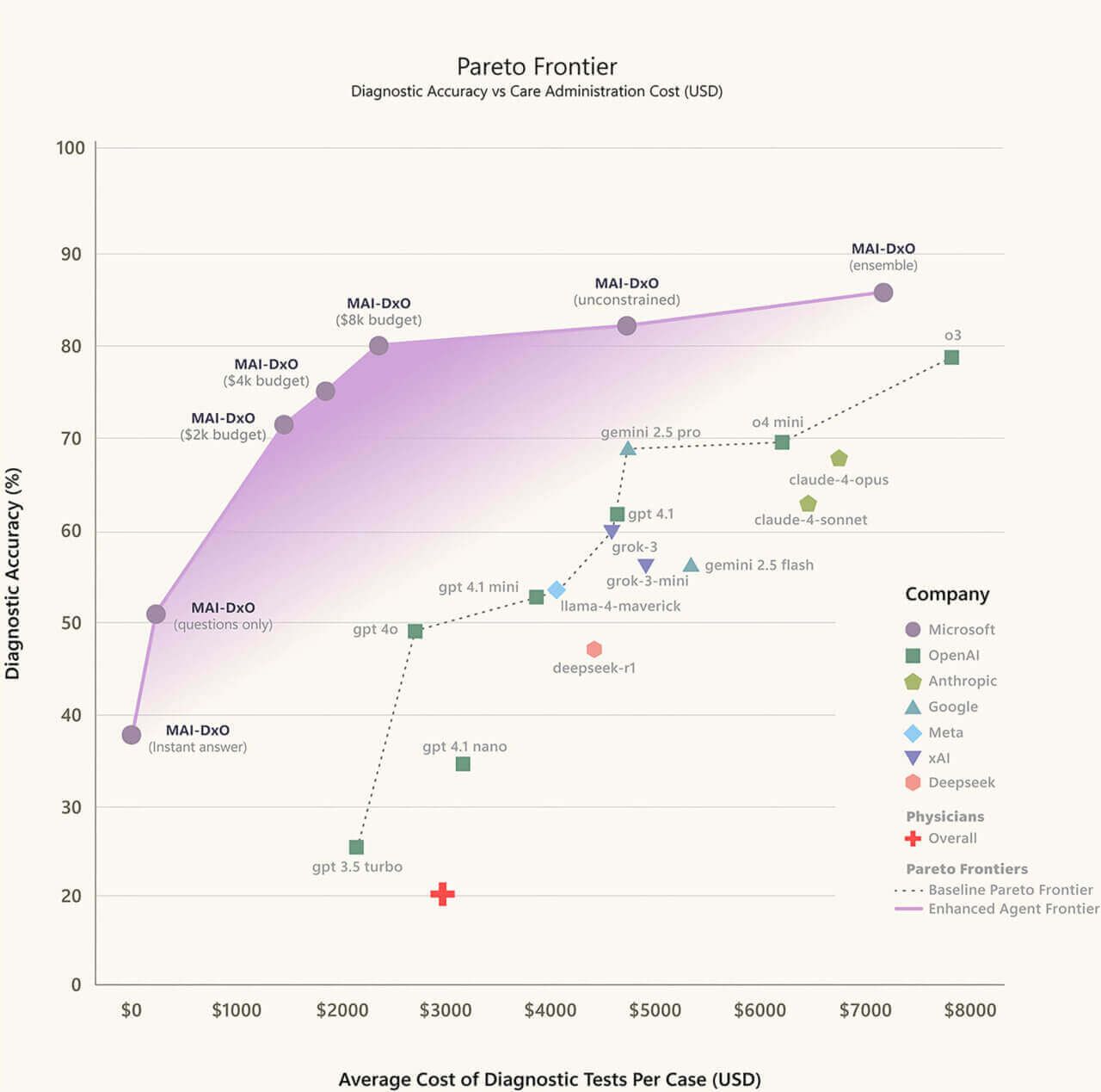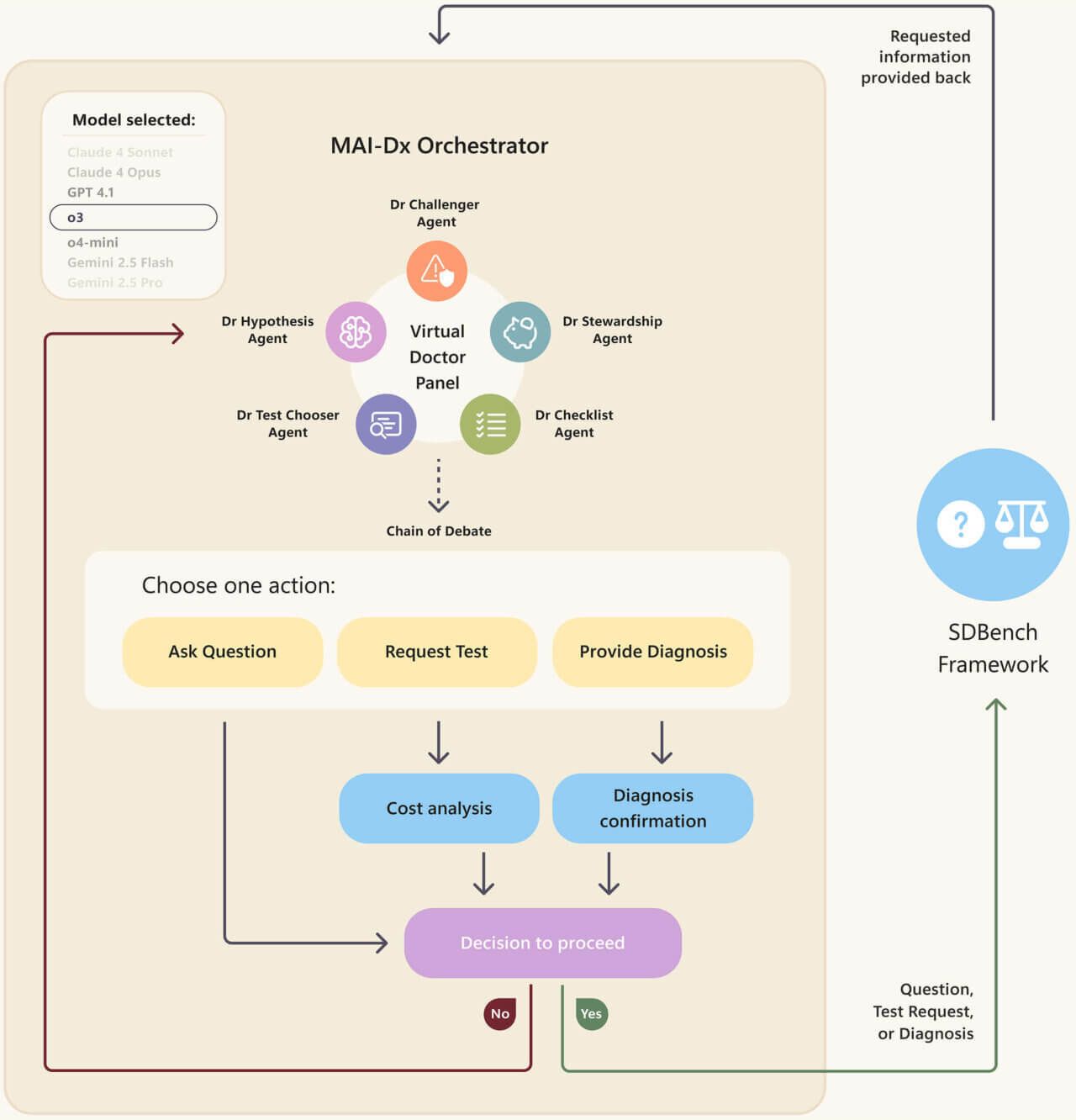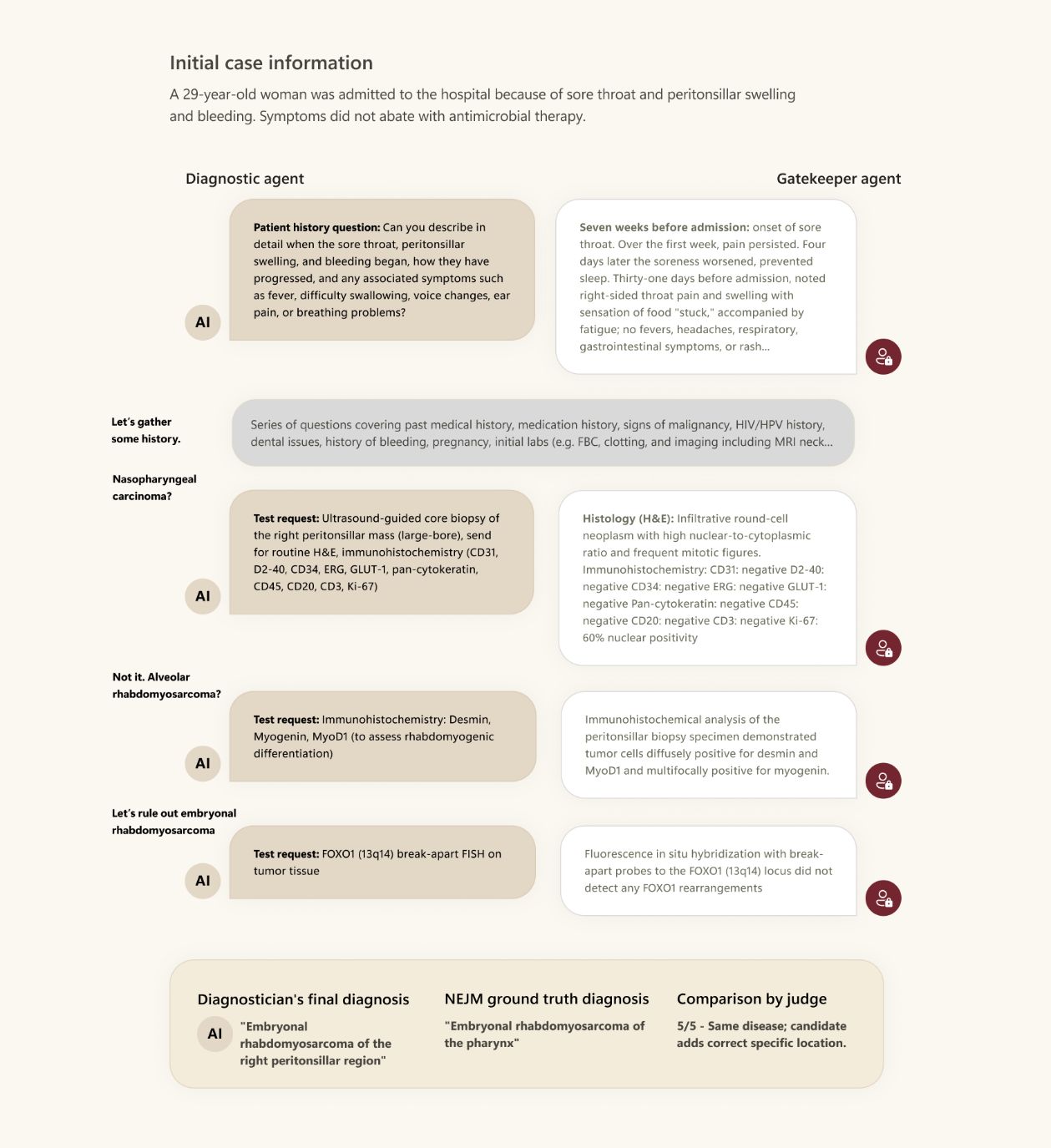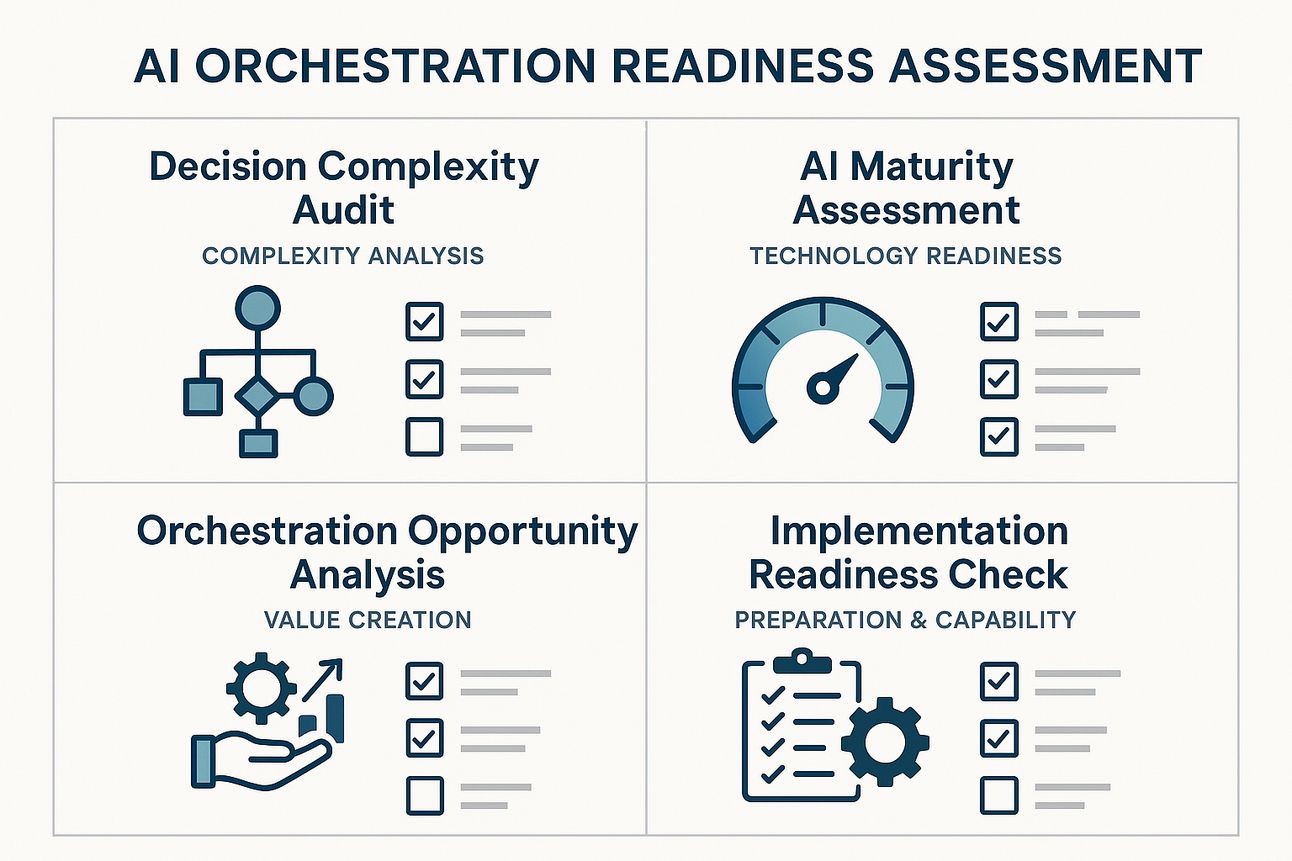About
Microsoft just achieved something that sounds like science fiction: AI that diagnoses the most complex medical cases better than experienced doctors.
But the real story isn't about healthcare—it's about the 5 breakthrough principles that every business leader needs to understand about the future of AI strategy.
Important note: While full AI orchestration is currently most practical for larger organizations, the underlying principles apply to businesses of all sizes. Whether you implement these concepts with human teams today or AI systems tomorrow, understanding this shift is crucial for every leader.
Introduction
Why This Matters Beyond Healthcare
Microsoft sees over 50 million health-related AI sessions daily across their consumer products. With U.S. healthcare spending approaching 20% of GDP and an estimated 25% of that being waste, this breakthrough points toward massive efficiency gains.
But the real breakthrough isn't medical—it's methodological. Microsoft cracked the code on making AI systems that actually reason through complex, multi-step problems like expert teams.
🏥 The Medical Superintelligence Achievement
While your competitors debate whether AI actually works, Microsoft just proved AI can achieve what they're calling "medical superintelligence."
The staggering results:
Microsoft's AI Diagnostic Orchestrator (MAI-DxO): 85.5% accuracy
Experienced physicians (5-20 years experience): 20% accuracy
Individual AI models: Significantly lower than orchestrated systems

Source: Microsoft AI
This wasn't tested on simple medical school exams. Microsoft evaluated their system against 304 of the most diagnostically complex cases published in the New England Journal of Medicine (NEJM)—cases that typically require multiple specialists and advanced testing to solve.
But here's the kicker: the AI didn't just achieve better diagnostic accuracy—it also delivered lower overall testing costs than human physicians or any individual AI model.
Lesson
#1: The Orchestration Advantage—Teams Beat Individuals
What Microsoft Discovered: Instead of relying on a single AI model, they built a virtual panel of specialist AI agents working together:

Dr Challenger Agent: Questions assumptions and challenges diagnoses
Dr Hypothesis Agent: Generates potential solutions
Virtual Doctor Panel: Provides diverse medical perspectives
Dr Stewardship Agent: Manages resource allocation and costs
Dr Test Chooser Agent: Selects optimal diagnostic tests
Dr Checklist Agent: Ensures nothing is missed
Why This Matters: Your best business decisions don't come from one person—they come from diverse teams bringing different perspectives. Microsoft proved the same principle applies to AI.
How to Apply:
For Larger Organizations: Design multi-AI workflows with specialized functions for complex decisions
For Smaller Businesses: Start by consciously assigning different "specialist roles" to team members (or even to yourself wearing different hats)
Foundation Building: When facing complex decisions, ask yourself: "Who would challenge this assumption? Who would focus on costs? Who would ensure quality?"
Immediate Step: Next complex decision, try the "virtual specialist team" approach with your current resources
Watch-Out: Orchestrated systems require more sophisticated infrastructure than simple AI tools. Start with your highest-impact use cases.
Lesson
#2: Sequential Decision-Making Beats One-Shot Analysis
What Microsoft Discovered: Medical AI typically scores near-perfect on multiple-choice medical licensing exams but fails at real diagnosis. Microsoft succeeded by building "Sequential Diagnosis"—an iterative process where AI systems:
Start with initial patient presentation
Ask follow-up questions
Order specific tests
Analyze results
Gradually narrow down possibilities
Reach final diagnosis

Why This Matters: Complex business decisions aren't multiple choice. They're iterative detective processes where you gather information, test hypotheses, and refine your understanding.
How to Apply:
For Any Size Business: Map how you actually make your most important decisions
Start Simple: Instead of trying to solve complex problems in one AI prompt, break them into phases
Foundation Practice: Next complex decision, try: Gather initial info → Ask follow-up questions → Test assumptions → Decide
Advanced Application: Build AI workflows that can request additional information and iterate
Immediate Applications by Business Size:
Small Business: Use AI for initial research, then ask follow-up questions based on what you learn
Medium Business: Create decision templates that guide sequential analysis
Large Business: Design AI systems that can request additional data and iterate through scenarios
Real-World Applications:
Financial Services: Loan decisions requiring multiple risk assessments
Legal: Case research building from initial facts to comprehensive strategy
Manufacturing: Quality control requiring multiple inspection points
Consulting: Due diligence requiring progressive investigation
Lesson
#3: Cost-Aware AI Delivers Better ROI
What Microsoft Discovered: Each diagnostic test in their system incurred virtual costs reflecting real healthcare expenditures. This prevented AI from ordering every possible test regardless of expense, patient discomfort, or care delays. The result: better outcomes at lower costs.
Why This Matters: Without constraints, AI systems default to using maximum resources. Smart constraints actually improve both performance and efficiency.
How to Apply:
Set resource constraints on AI implementations: Define budgets for AI analysis time, data processing, or expert consultation
Build cost-awareness into AI decisions: Make your AI systems consider efficiency, not just accuracy
Track ROI metrics: Measure both decision quality AND resource consumption
Strategic Applications:
Procurement: AI that balances vendor quality with cost constraints
Marketing: Campaign optimization considering both performance and budget
R&D: Innovation decisions weighing potential returns against development costs
Lesson
#4: Specialization Within Coordination
What Microsoft Discovered: Different AI agents played specific roles—some generated hypotheses, others challenged assumptions, others managed costs. This specialization within coordination delivered superior results to generalist approaches.
Why This Matters: In business, you don't want a generalist handling specialist tasks. But you need coordination between specialists. AI orchestration mirrors your best organizational structures.
How to Apply:
Map specialist functions in your AI strategy:
Analysis specialist (data interpretation)
Challenge specialist (questioning assumptions)
Cost specialist (resource optimization)
Quality specialist (verification and compliance)
Design handoffs between AI specialists: How does information flow between different AI agents?
Maintain human oversight: Orchestrated AI still needs human direction and validation
Industry Applications:
Investment Analysis: Research specialists, risk specialists, market specialists working together
Product Development: Technical feasibility, market research, financial modeling coordination
Strategic Planning: Competitive intelligence, scenario planning, implementation specialists
Lesson
#5: Real-World Complexity Requires Real-World Testing
What Microsoft Discovered: AI performance on standardized tests (like medical licensing exams) doesn't predict real-world performance. Microsoft tested on actual published medical cases—the most diagnostically complex scenarios in clinical medicine.
Why This Matters: Most businesses test AI on clean demo data or simplified scenarios. Microsoft's breakthrough came from testing on the hardest real-world problems.
How to Apply:
Test AI on your actual complex business problems: Not demos or simplified scenarios
Use your most challenging historical cases: What decisions took your team the longest to resolve?
Benchmark against your best human performance: Compare AI to your top performers, not average ones
Validate with real stakes: Test with actual business consequences, not just pilot projects
Implementation Framework:
Identify your "NEJM cases": Your most complex, high-stakes decisions
Create test scenarios: Use actual historical cases with known outcomes
Measure both accuracy and efficiency: Track decision quality AND resource consumption
Compare to expert performance: Benchmark against your best teams, not industry averages
Action
🎯 A Strategic Action Plan: Preparing for the Orchestration Future
Microsoft's breakthrough proves that orchestrated AI can deliver 4x better performance than individual approaches. But before you chase this competitive advantage, you need to honestly assess whether your organization is ready for this level of AI sophistication.
This isn't about whether you should use AI—it's about whether you're ready to implement the kind of orchestrated, multi-agent systems that create sustainable competitive advantages. Use this framework to evaluate your readiness and identify the gaps you need to address first.
Important Context: Full AI orchestration is currently most relevant for larger organizations with complex decision-making needs and sophisticated technical infrastructure. But every business—regardless of size—can benefit from understanding these principles and laying the foundation.

The AI Orchestration Readiness Assessment. Source: The Context Window
1. Decision Complexity Audit
What are your 3 most complex, high-impact business decisions?
How many different experts/perspectives do these decisions currently require?
What's the cost of getting these decisions wrong?
How long do these decisions typically take?
2. Current AI Maturity Assessment
Are you successfully using single AI tools for simpler tasks?
Do you have clean, integrated data for AI systems to work with?
Can your technical team manage and monitor complex AI outputs?
Have you established AI governance and quality control processes?
3. Orchestration Opportunity Analysis
Where would 4x better decision accuracy create the most value?
What decisions currently bottleneck your business growth?
How much do you spend on expert consultants for complex analysis?
Which processes require multiple specialist inputs?
4. Implementation Readiness Check
Can your organization handle more sophisticated AI outputs?
Are you prepared for the change management required?
Do you have budget for orchestrated AI infrastructure?
Can you start with pilot projects on non-critical decisions?
Closing
⚠️ Critical Watch-Outs by Business Size
For All Businesses
Don't Chase the Shiny Object: These principles work whether you apply them with human teams or AI systems. Start with your highest-impact decisions where better reasoning would create significant value.
For Larger Organizations Considering AI Orchestration
Research vs. Reality: Microsoft's system is research-only. When evaluating vendors:
Ask for specific performance benchmarks on real-world problems
Request proof of multi-agent coordination capabilities
Test with your specific use cases, not generic demos
Integration Complexity: Orchestrated AI requires sophisticated infrastructure:
Data integration across multiple systems
Quality control and monitoring capabilities
Skilled technical teams to manage complex AI workflows
For Smaller Businesses Building Foundations
Start Simple: Don't try to implement complex AI orchestration before mastering basic AI tools and decision processes.
Focus on Principles: The value is in better decision-making approaches, not necessarily the technology. Apply orchestration thinking with your current resources.
Prepare Don't Rush: Build the foundations (documented processes, clean data, AI literacy) before the technology becomes accessible to smaller businesses.
💡 The Bottom Line
Microsoft's medical superintelligence breakthrough shows us where AI is heading—toward systems that think like expert teams rather than individual tools.
For every business, regardless of size, the 5 principles matter:
Team thinking beats individual analysis (apply with human teams now, AI teams later)
Sequential reasoning beats one-shot decisions (break complex problems into phases)
Resource-aware decisions deliver better ROI (set constraints on time, budget, scope)
Specialization within coordination wins (assign different perspectives to complex problems)
Real-world testing reveals true performance (test on your actual challenges, not demos)
The opportunity varies by business size:
Larger organizations: Can explore orchestrated AI systems for complex decisions
Smaller businesses: Can apply these principles with current resources and build foundations for future AI capabilities
Everyone: Can start thinking like orchestrated systems and prepare for when these tools become more accessible
The companies that understand these principles—and start applying them at their scale—will be ready when orchestrated AI becomes mainstream.
Whether you implement it with human teams today or AI teams tomorrow, better decision-making compounds into competitive advantage.
Start where you are, with what you have. The orchestration revolution isn't just about the technology—it's about the mindset. 🚀
We are out of tokens for this week's context window!✋
Keep reading up, keep learning and don’t be a follower of the AI revolution, instead be part of it! 💪
The Context Window Team!
Follow the author:
X at @hashisiva | LinkedIn


